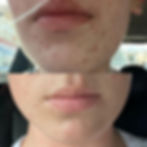ACNE
ACNE
Acne can often lead to debilitating mental health problems like low self-esteem, anxiety & depression. With 80% of people suffering from acne at some point in their lives this is a means of great concern for the overall health of our society. Affecting adults as well as teenagers it can take years for acne to clear up naturally as the body's hormonal and immunity systems realign and strengthen. The chances of it returning are also very high if the cause of the acne is not addressed properly.
There is often more than one cause when it comes to acne meaning there are no quick, one method fix. A chronic inflammatory condition of the hair follicle and its sebaceous gland, acne closely reflects the state of the body’s hormonal and immunity systems.
There are both genetic or external triggers such as, birth control pills, cosmetics, hormonal imbalances, medications, picking and squeezing pimples, friction and pressure on the skin, lifestyle and climate conditions.
Stress however is always an ingredient in the cocktail of acne causes. It sends a myriad of signals around the body including messages to the skin to increase the production of hair and sebaceous oil. This accentuates the problem of dead cells blocking the follicle and trapping bacteria and oil in the pore. As a result, pustules, cysts, blackheads, and blocked pores form which can often leave scars when prevented from healing properly. It comes as no surprise then with the increase of stressors in our everyday lives, the number of acne cases has risen. Google searches for acne are also at the highest they have ever been in the past fifteen years.
Acne most commonly develops on the Face, Back + Chest
There are 6 main types of spot caused by acne:
Blackheads – small black or yellowish bumps that develop on the skin; they're not filled with dirt, but are black because the inner lining of the hair follicle produces pigmentation (colouring)
Whiteheads – have a similar appearance to blackheads, but may be firmer and won't empty when squeezed
Papules – small red bumps that may feel tender or sore
Pustules – similar to papules, but have a white tip in the centre, caused by a build-up of pus
Nodules – large hard lumps that build up beneath the surface of the skin and can be painful
Cysts – the most severe type of spot caused by acne; they're large pus-filled lumps that look similar to boils and carry the greatest risk of causing permanent scarring
Choosing the best treatment all depends on the severity of the acne, age and lifestyle. However, a thorough skin analysis will be done prior to recommending any of the treatments or combination of treatments listed below
Links to recommended treatments:
CONTACT




